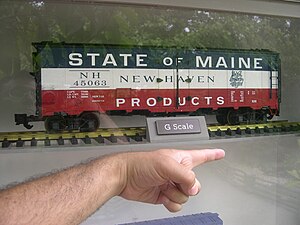G-scale
| G scale | |
|---|---|

G scale train model
|
|
| Scale ratio | 1:22.5 |
| Standard(s) | originally LGB |
| Model gauge | 45 mm (1.772 in) |
| Prototype gauge | 1,000 mm (3 ft 3 3⁄8 in) metre gauge |
G scale (or G gauge) is a scale for model railways which, because of its size and durability, is often used outdoors. Such installations are known as garden railways.
G scale was introduced by Ernst Paul Lehmann Patentwerk under the brand name LGB and was intended for indoor and outdoor use. Lehman Patentwerk, founded in 1881, started producing LGB in 1968. The remains of the company were bought by Märklin and production of certain items continues.
The G name comes from the German word groß meaning "big". More recently some people have come to interpret it as standing for garden scale.
A railroad gauge is the distance between the railheads. The most common full scale practice has rails spaced 4 ft 8 1⁄2 in (1,435 mm) standard gauge apart whereas some narrow-gauge railways (serving mines, etc.) have rails only 3 ft (914 mm) apart. Although often built with standard-sized doors, a narrow-gauge train is in most other respects smaller than its standard-gauge cousin: its cars are generally narrower and shorter, allowing them to navigate often more sharply curved and lighter built tracks.
Model trains are built to represent a real train of standard or narrow gauge. In an HO model, for example, 16.5 mm gauge track represents standard gauge and a narrower-gauge track such as 9 mm N gauge is used to represent real narrow gauge. G model-railways depart from this and always use the same gauge with the trains instead built in different sizes depending on whether they are intended to represent standard-gauge or narrow-gauge trains. Because of this it might be more correct to speak of "G Gauge," the consistent aspect being the gauge, 45 mm (1.772 in), and not the scale.
The 45 mm gauge originated from '1 gauge' or 'Gauge One' which was first used in Europe and England and used to model standard gauge trains in the scale of 1:32.
LGB were first to adopt the term 'G Scale' and used the gauge of 45 mm (1.772 in) to model 1,000mm gauge European trains in 1:22.5 scale.
...
Wikipedia
